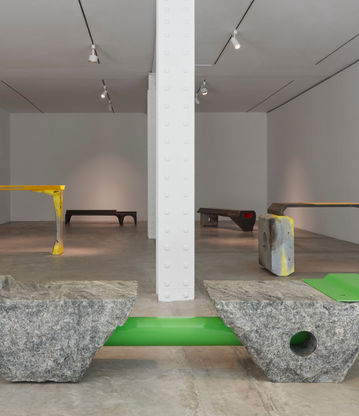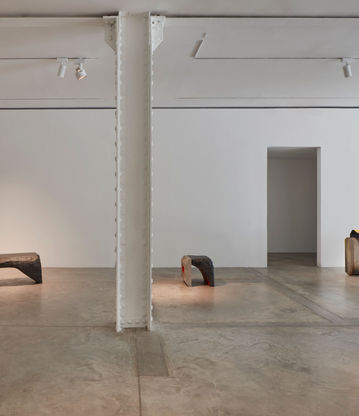
Samuel Ross
COARSE
In Samuel Ross’s second solo presentation at Friedman Benda (and his New York debut), the organic and the artificial are simultaneously contrasted and harmonized. The industrial materials he uses are soaked in turmeric, honey, and milk before being processed, a sort of ritualistic process for Ross that brings a distinct tenderness to coarse mediums. Pops of over-saturated color in bright green and yellow hues stand out against stone and wood.
The results are compelling and pleasantly disruptive, especially displayed in a gallery space. The pieces are unmistakably man made, but evoke natural forms so clearly– calling to mind seaside cliffs and mossy rocks –that they almost seem out of place in this environment. Even seen in the context of furniture design, these works are meant to be interacted with, to be integrated into our daily lives to serve a purpose. Many pieces like “Anaesthesia II” and “Border” contain holes that act almost as windows, so that the surroundings become even more of a part of the piece. The setting is inescapable. They are both reflections of our world and participants in it. Seeing them displayed in a gallery makes one reassess their value as objects of beauty as well as function. Spatial relationships are an undercurrent driving “Coarse”-- who gets to take up space, who is worthy of sharing space, what the spaces we create can tell us about who we are. Eventually these pieces will likely arrive in private collections, but, temporarily, the white cube gallery atmosphere invites this line of questioning.
A product and fashion designer, much of Ross’s oeuvre falls under this umbrella of functional art, and his work is situated in the larger dialogue about the distinction between fine art and contemporary design. Beginning by writing poetry, his creative process involves funneling abstract themes into (sometimes literally) concrete forms. There is a certain performativity involved in creating objects of servitude– Ross has an acute understanding of this kind of engagement through his work in fashion, and with this presentation he subverts expectations of function while also speaking to the nature of pragmatism itself.
In “Coarse,” Ross’s personal identity informs the work as much as larger cultural conversations about territory and diaspora. Ross gravitates towards brutalist sensibilities because they remind him of the UK working class estates he grew up around, and because the shortcomings of the movement symbolize the power of failure. His parents are also artists, and themes of ancestry and lineage permeate his art. The idea that furniture is an extension of the body is particularly evident in pieces like “Fire Opens Stone” and “Anaesthesia”, which explore objects as a microcosm for the history and memory that living bodies also carry.
Walter Darby Bannard once remarked “Art is not truth. Truth conforms to reality. Art invents reality.” Ross’s work challenges this notion. In an interview for Friedman Benda’s CULTURED, Ross remarked that “to serve well, you must be truthful.” His presentation is aptly named. The pieces in the show are coarse– raw, rugged, deliberately rough around the edges. They conform to our reality, but they also create a world of their own– one where the inconsistencies and juxtapositions of this world are exaggerated, but the indelible marks left by history feel remarkably true to life. In short, the objects displayed in “Coarse,” are undeniably truthful, but they are also undeniably art.
by Hannah Hightman, May 17, 2023
Images Courtesy of Friedman Benda and Samuel Ross. Photography by Timothy Doyon





